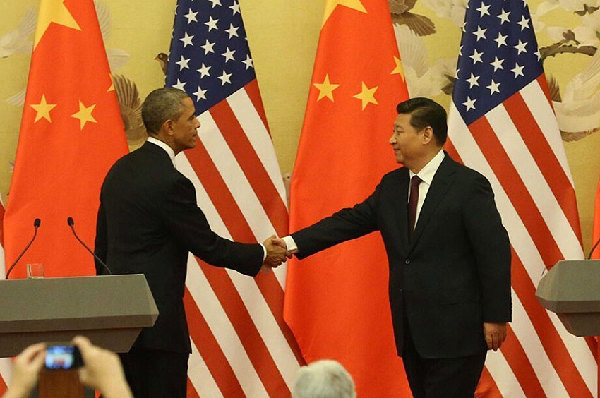
File photo: Chinese President Xi Jinping (R) shakes hands with U.S. President Barack Obama at a press conference following their talks at the Great Hall of the People in Beijing, capital of China, Nov. 12, 2014. (Xinhua Liu Weibing)
Over the past thirty-six years since China and U.S. established diplomatic relations, the two countries have developed a new road which has avoided confrontation between two major countries. For instance, the fruitful 7th U.S.-China Strategic and Economic Dialogue and the 6th U.S.-China High-Level Consultation on People-to-People Exchange are the valuable result of the two countries’ constant pursuit of common strategic interests and attempts to promote bilateral relations.
Reviewing the bumpy road of the development of Sino-U.S. relations, each phase had peculiar core affairs crying for attention. At present, it seems that conflicts may happen soon between the two countries in Asian-Pacific region. The main reason is that the U.S. feels that its dominant position in the region over the past seventy years after WWII has changed due to China’s development. There is no doubt that the region is in the face of centennial transition of geopolitical security conditions, resulting in the two major issues of “strategic mutual trust” and “Asian-Pacific interaction” in the development of Sino-U.S. relations.
The U.S. has transferred its strategic focus to the East and constantly enhanced security arrangements and military strength in Asia-Pacific region. In recent years, in some American people’s eyes, China’s diplomatic measures, including upholding sovereignty over territorial waters and expanding maritime rights and interests, advocating the establishment of Asia-Pacific security order and improving surrounding security environment, are aimed at showing muscle to the outside world and challenging U.S. military advantage and strategic dominance in the region. As for China’s reclamation projects in China’s territorial waters of the South China Sea, some American people overreacted, and some think tanks and scholars even clamored for changing strategy against China and expand “rebalancing” so as to counter China.
However, some people of insight pointed out that it’s the lack of “mutual trust” that influences the development of Sino-U.S. relations, and more precisely, it’s the “Thucydides’s Trap” of conflict among great powers in their hearts. Indeed, any change in strength, interest and situation between two countries can turn “strategic mutual trust” into “strategic distrust”. As “Trust” is fragile while “Distrust” is inflammable, China and the U.S. must urgently establish strategic mutual trust so as to prevent the precious “Trust” from burning down by the “Distrust”.
In order to build Sino-U.S. “strategic mutual trust”, which is the basis for the establishment of Sino-U.S. new-type relations between major powers, we have to study cooperation and dispute in the history of the two countries' relations. China and the U.S. cooperated to confront the Soviet Union decades ago, nowadays the two countries are blaming each other on cyber security, investment agreement and monetary policy. However, in the author’s opinion, these disputes can definitely be transformed into cooperation.
It’s not blind optimism. Close cooperation on some global issues between the two countries has actually been achieved through disputes, including driving global economy via coordinating micro policies, absorbing international commodities via trade of 600 billion U.S. dollars, stabilizing finance via China’s long-term purchase of U.S. government bonds and speeding up structural transformation of economy with each other’s help. Therefore, neither party is supposed to doubt the other habitually or even overact when the two sides can’t achieve consensus on major issues for the moment; instead, the two sides should nurture a good habit of cooperation.
The Asian-Pacific region, where many issues about cooperation and dispute have taken place between the two countries, can become the “trial field” for China and the U.S. to build a new type of relations between major powers. The two countries can make efforts to find a way for coexistence—building new type of Asian-Pacific relations, especially the building of new type of military security relations, so as to enrich the content of the establishment of Sino-U.S. new-type relations between major powers and expand its prospect.
Then what are ways of cooperation for China and the U.S. to promote mutual trust? There is an optimistic opinion in strategic fields that tangible measures, including stabilizing situation in Afghanistan, prevention of the proliferation of weapons of mass destruction, upholding the security of seaways, promoting trade liberalization, keeping multilevel military contacts as well as coping with climate change, developing clean energy and disaster warning, can promote Sino-U.S. cooperation and win-win results and enhance mutual trust so as to build and consolidate Sino-U.S. new-type major-country relations.
Some American scholars suggest that China’s eagerness for respect on affairs of Asian-Pacific security and economy deserves high attention. China, of course, also acknowledges the U.S.' practical interests and is willing to see its positive role in the region. To sum up, joint efforts of both sides is the decisive factor in building Sino-U.S. new-type major-country relations despite the bumpy and long road ahead. Bright prospects for both sides will not be possible without enhancing “strategic mutual trust”.
Contributed by Lu Zhongwei, former President of China Institutes of Contemporary International Relations, for Guangming Daily
Translated by Zhang Zhou